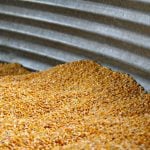It appears that 2004-05 will be one of those rare years when nature is in a good mood.
All around the world, farmers are smiling at their developing crops with prospects for average to large harvests.
The only significant problem this year was in the U.S. winter wheat belt, where drought in western regions cut yields severely.
Winter wheat production is forecast at 40 million tonnes. This is down four percent from last month’s estimate and 14 percent below 2003. But globally, the U.S. Department of Agriculture forecasts wheat production will climb to 598 million tonnes, up six million from the June report. Consumption is forecast to also increase, but not as much, leading to an increase in 2004-05 world wheat ending stocks to 132.2 million tonnes. That is up from 130.5 million tonnes in 2003-04, reversing a multi-year trend of falling world wheat stocks.
Read Also

Volatile temperatures expected for this winter
DTN is forecasting a lot of temperature variability in the Canadian Prairies this winter. Precipitation should be close to average.
U.S. corn and soybean production also look good.
Crops in Western Canada are generally late, with frost worries in the background, but good moisture bodes well for yields.
In Europe, where bad weather plagued crops last year, the expectation is for good yields this year with total production about average. The only problem there relates to too much rain in recent weeks threatening to downgrade the quality in durum and malting barley.
Australia is also looking at a good crop although recent forecasts have shaved the outlook to normal from earlier predictions of bumper yields.
The monsoon rains in India have arrived on schedule.
Farmers are seeding winter wheat in Argentina in generally favourable conditions.
These comfortable production prospects have calmed grain futures traders who only a few short months ago were feverishly bidding prices higher. Now they are steadily pushing prices down.
Of course, that could change if the weather turns. For example, a sustained heat wave, say in the U.S. Midwest, would push corn and soybeans higher.
But there is no indication that the weather is going to turn sour.
That means market direction in the coming year will be influenced more by demand developments than by production problems.
Asian demand, particularly from China, will be crucial in sustaining farm commodity prices.
Borrowing restrictions and other measures to slow China’s overheated economy have reduced the demand for imported soybeans. The policy so far seems to have delivered the desired soft landing that slows but does not stop economic expansion.
There are some indications that Chinese buyers will resume buying later this summer.
A wild card is avian flu, which killed 24 people in Asia last year and forced the destruction of millions of birds. China, Vietnam and Thailand have had outbreaks in poultry in recent weeks, throwing new scares into Asian feed markets.
The United Nations Food and Agriculture Organization warned that the bird flu virus was more widespread than previously thought and therefore will be harder to eliminate.
It urged health officials to tighten surveillance to head off new crises.














